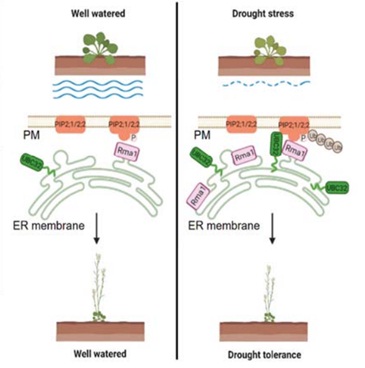Drought is a severe environmental stress with a direct impact on plant growth and plant yield. Therefore, exploring the regulation mechanism of drought stress response and breeding drought-tolerant plants are key strategies to improve plant drought tolerance.
ERAD (Endoplasmic reticulum-associated degradation) plays an important role in the growth and stress response of plants, through clearing the misfolded proteins and also some normal folding proteins. Research team led by Prof. XIE Qi from the Institute of Genetics and Developmental Biology of the Chinese Academy of Sciences worked on the regulation between ubiquitination and stresses response. They have reported a series work about the function of ERAD in stress responses.
Recently, researchers led by Prof. XIE Qi revealed the
UBC32-Rma1 complex increases drought stress tolerance in plant, which provides a new mechanism of ERAD in drought stress regulation. UBC32 is an ubiquitin conjugating enzyme localized on endoplasmic reticulum (ER) membrane and is also an important component in plant ERAD. The expression of UBC32 can be induced by multiple stresses. As an ERAD component, UBC32 mediates the degradation of misfolded proteins. At the same time, itself can be regulated by ERAD system.
Researchers found overexpression of UBC32 significantly increased drought tolerance of Arabidopsis, while ubc32 mutants reduced the drought tolerance. Through IP-MS, they found aquaporins PIP2;1 and PIP2;2 interacted with UBC32. UBC32 promotes the turnover of PIP2;1 and PIP2;2. Furthermore, RING type E3 ligase Rma1 forms E2-E3 pair with UBC32 and this pair associates with the S280/283 phosphorylated PIP2;1 and then ligates ubiquitin to the 276th lysine residue of PIP2;1 and promotes the degradation of PIP2;1 to increase plant drought tolerance.
Overexpression of Arabidopsis UBC32 in rice significantly improves drought tolerance of rice. These findings provide a possibility for breeding and/or engineering of drought tolerant rice and other crops in the future.
The paper entitled “ERAD-related E2 and E3 enzymes modulate the drought response by regulating the stability of PIP2 aquaporins” was published in The Plant Cell on May 20, 2021.
This study was supported by the National Key Research and Development Program of China (2016YFA0500500) and National Natural Science Foundation of China (31700234).
UBC32-Rma1 function together to target phosphorylated PIP2;1 and PIP2;2 for ubiquitin-dependent degradation to enhance drought tolerance in plants. (Image by IDGB)
Contact:
Dr. XIE Qi
Institute of Genetics and Developmental Biology, Chinese Academy of Sciences
 UBC32-Rma1 function together to target phosphorylated PIP2;1 and PIP2;2 for ubiquitin-dependent degradation to enhance drought tolerance in plants. (Image by IDGB)Contact:Dr. XIE QiInstitute of Genetics and Developmental Biology, Chinese Academy of SciencesEmail: qxie@genetics.ac.cn
UBC32-Rma1 function together to target phosphorylated PIP2;1 and PIP2;2 for ubiquitin-dependent degradation to enhance drought tolerance in plants. (Image by IDGB)Contact:Dr. XIE QiInstitute of Genetics and Developmental Biology, Chinese Academy of SciencesEmail: qxie@genetics.ac.cn CAS
CAS
 中文
中文




.png)
